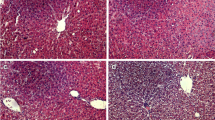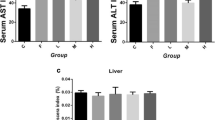Abstract
Previous studies have reported that excessive fluoride exposure induced liver damage. However, the underlying mechanism of fluoride-induced hepatic toxicity is still unclear. Hence, this study was aimed to evaluate the fluoride-induced apoptosis, autophagy, and IL-17 signaling pathway-related genes to explore the possible mechanisms of NaF-induced liver injury in mice. For this, 48 male mice were allotted randomly to four groups, treated with deionized water, 25, 50, 100 mg/L NaF for 150 days continuously. Our results suggested that treatment with NaF decreased the PAS staining-positive area, with a concomitant increase in liver score, and serum ALT and AST levels which indicated that NaF induced the liver injury. In addition, the qRT-PCR, immunohistochemistry, and western blotting results indicated that NaF exposure activated IL-17 signaling, apoptosis, and autophagy pathways. In summary, these results suggested that NaF induced apoptosis and autophagy in liver by activating the IL-17 signaling pathway, eventually leading to impaired liver function.







Similar content being viewed by others
References
Baranova IN, Souza AC, Bocharov AV et al (2016a) Human SR-BI and SR-BII potentiate lipopolysaccharide-induced inflammation and acute liver and kidney injury in mice. J Immunol 196(7):3135–3147
Baranova IN, Souza ACP, Bocharov AV et al (2016b) Human SR-BI and SR-BII potentiate LPS-induced inflammation and acute liver and kidney injury in mice. J Immunol 196(7):3135–3147
Barbier O, Arreolamendoza L, Del Razo LM (2010) Molecular mechanisms of fluoride toxicity. Chem Biol Interact 188(2):319–333
Bo X, Mu D, Wu M, Xiao H, Wang H (2018) The morphological changes and molecular biomarker responses in the liver of fluoride-exposed Bufo gargarizans larvae. Ecotoxicol Environ Saf 151:199
Campos-Pereira FD, Lopes-Aguiar L, Renosto FL et al (2017) Genotoxic effect and rat hepatocyte death occurred after oxidative stress induction and antioxidant gene downregulation caused by long term fluoride exposure. Chem Biol Interact 264:25–33
Cao J, Chen J, Wang J et al (2013) Effects of fluoride on liver apoptosis and Bcl-2, Bax protein expression in freshwater teleost, Cyprinus carpio. Chemosphere 91(8):1203–1212. https://doi.org/10.1016/j.chemosphere.2013.01.037
Cao J, Chen J, Xie L, Wang J, Feng C, Song J (2015) Protective properties of sesamin against fluoride-induced oxidative stress and apoptosis in kidney of carp (Cyprinus carpio) via JNK signaling pathway. Aquat Toxicol 167:180–190
Cheng Z, Zhu Q, Dee R et al (2017) Focal adhesion kinase-mediated phosphorylation of Beclin1 suppresses cardiomyocyte autophagy and initiates hypertrophic growth. J Biol Chem 292(6):2065–2079
Chenuet P, Fauconnier L, Madouri F et al (2017) Neutralization of either IL-17A or IL-17F is sufficient to inhibit house dust mite induced allergic asthma in mice. Clin Sci 131(20):2533
Cristina CR, Gabriela M, Antonio R, Roncero DP, Carmen MIG RR (2015) Autophagy contributes to regulation of nuclear dynamics during vegetative growth and hyphal fusion in Fusarium oxysporum. Autophagy 11(1):131–144
Cui YQ, Liu YJ, Zhang F (2018) The suppressive effects of Britannin (Bri) on human liver cancer through inducing apoptosis and autophagy via AMPK activation regulated by ROS. Biochem Biophys Res Commun 497(3):916–923
Dong C, Cao J, Cao C et al (2016) Effects of fluoride and aluminum on expressions of StAR and P450scc of related steroidogenesis in guinea pigs’ testis. Chemosphere 147:345
Ge Y, Chen L, Yin Z et al (2018) Fluoride-induced alterations of synapse-related proteins in the cerebral cortex of ICR offspring mouse brain. Chemosphere 201:874–883
Gooderham M, Cj PDLR, Rubiogomez GA, Papp K (2015) Interleukin-17 (IL-17) inhibitors in the treatment of plaque psoriasis: a review. Skin Ther Lett 20(1):1–5
Guo HS, Fu BH, Ji PG et al (2015) Effects of fluoride on DNA damage and caspase-mediated apoptosis in the liver of rats. Biol Trace Elem Res 166(2):173–182
Han H, Sun Z, Luo G, Wang C, Wei R, Wang J (2015) Fluoride exposure changed the structure and the expressions of reproductive related genes in the hypothalamus–pituitary–testicular axis of male mice. Chemosphere 135:297–303
Han J, Bae J, Choi CY et al (2016) Autophagy induced by AXL receptor tyrosine kinase alleviates acute liver injury via inhibition of NLRP3 inflammasome activation in mice. Autophagy 12(12):2326–2343
He P, Wang AG, Xia T et al (2009) Mechanism of the neurotoxic effect of PBDE-47 and interaction of PBDE-47 and PCB153 in enhancing toxicity in SH-SY5Y cells. Neurotoxicology 30(1):10–15
Hu L, Ying J, Mu L, Yu S, Liang Z, Clinch C (2009) Fluoride toxicity in the male reproductive system. Fluoride 42(4):260–276
Karabulut S, Afsar ÇU, Karabulut M et al (2016) Evaluation of serum interleukin-17 (IL-17) levels as a diagnostic marker in pancreatic adenocarcinoma. J Gastrointest Cancer 47(1):47–54
Khan ZN, Sabino IT, de Souza Melo CG, Martini T, da Silva Pereira HAB, Buzalaf MAR (2018) Liver proteome of mice with distinct genetic susceptibilities to fluorosis treated with different concentrations of f in the drinking water. Biol Trace Elem Res. https://doi.org/10.1007/s12011-018-1344-8
Kim EK, Kwon JE, Lee SY et al (2017) IL-17-mediated mitochondrial dysfunction impairs apoptosis in rheumatoid arthritis synovial fibroblasts through activation of autophagy. Cell Death Dis 8(1):e2565
Kimura T, Isaka Y, Yoshimori T (2017) Autophagy and kidney inflammation. Autophagy 13(6):1
Kumar A, Bhatt M, Vyas G, Bhatt S, Paul P (2017) Sunlight induced preparation of functionalized gold nanoparticles as recyclable colorimetric dual sensor for aluminium and fluoride in water. ACS Appl Mater Interfaces 9(20):17359–17368
Lasithiotaki I, Antoniou KM, Derdas SP et al (2013) The presence of Merkel cell polyomavirus is associated with deregulated expression of BRAF and Bcl-2 genes in non-small cell lung cancer. Int J Cancer 133(3):604–611
Li M, Cai SY, Boyer JL (2017a) Mechanisms of bile acid mediated inflammation in the liver. Mol Asp Med 56:45–53
Li Y, Cui Y, Wang W et al (2017b) Effect of the serum inhibited gene (Si1) on autophagy and apoptosis in MCF-7 breast cancer cells. Cell Physiol Biochem 41(6):2268–2278
Lim EJ, Chin R, Nachbur U et al (2016) Hepatitis C-induced hepatocyte apoptosis following liver transplantation is enhanced by immunosuppressive agents. J Viral Hepat 23(9):730–743
Lin W, Wang N, Zhou K et al (2018) RKIP mediates autoimmune inflammation by positively regulating IL-17R signaling. EMBO Rep 19(6):e44951
Liu W, Jiang Y, Sun J et al (2018) Activation of TGF-beta-activated kinase 1 (TAK1) restricts Salmonella Typhimurium growth by inducing AMPK activation and autophagy. Cell Death Dis 9(5):570
Lodder J, Denaës T, Chobert MN et al (2015) Macrophage autophagy protects against liver fibrosis in mice. Autophagy 11(8):1280–1292
Lu Y, Luo Q, Cui H et al (2017) Sodium fluoride causes oxidative stress and apoptosis in the mouse liver. Aging 9(6):1623–1639
Lv SX, Qiao X (2018) Isovitexin (IV) induces apoptosis and autophagy in liver cancer cells through endoplasmic reticulum stress. Biochem Biophys Res Commun 496(4):1047–1054
Meng F, Wang K, Aoyama T et al (2012) Interleukin-17 signaling in inflammatory, Kupffer cells, and hepatic stellate cells exacerbates liver fibrosis in mice. Gastroenterology 143(3):765
Miao K, Zhang L, Yang S, Qian W, Zhang Z (2013) Intervention of selenium on apoptosis and Fas/FasL expressions in the liver of fluoride-exposed rats. Environ Toxicol Pharmacol 36(3):913
Oropesa-Ávila M, Cruz-Ojeda PDL, Porcuna J et al (2017) Two coffins and a funeral: early or late caspase activation determines two types of apoptosis induced by DNA damaging agents. Apoptosis 22(3):1–16
Pei J, Deng J, Ye Z et al (2016) Absence of autophagy promotes apoptosis by modulating the ROS-dependent RLR signaling pathway in classical swine fever virus-infected cells. Autophagy 12(10):1738–1758
Potz BA, Lawandy IJ, Clements RT, Sellke FW (2016) Alcohol modulates autophagy and apoptosis in pig liver tissue. J Surg Res 203(1):154
Qiu AW, Bian Z, Mao PA, Liu QH (2016) IL-17A exacerbates diabetic retinopathy by impairing Müller cell function via Act1 signaling. Exp Mol Med 48(12):e280
Reed M, Morris SH, Owczarczyk AB, Lukacs NW (2015) Deficiency of autophagy protein Map1-LC3b mediates IL-17-dependent lung pathology during respiratory viral infection via ER stress-associated IL-1. Mucosal Immunol 8(5):1118–1130
Ruiz-Vela A, Korsmeyer SJ (2007) Proapoptotic histone H1.2 induces CASP-3 and – 7 activation by forming a protein complex with CYT c, APAF-1 and CASP-9. FEBS Lett 581(18):3422–3428
Ryu H, Nam KY, Kim JS, Hwang SG, Song JY, Ahn J (2018) The small molecule AU14022 promotes colorectal cancer cell death via p53-mediated G2/M-phase arrest and mitochondria-mediated apoptosis. J Cell Physiol 233(6):4666–4676
Siddiqi NJ, Zargar S (2014) Effect of quercetin on cadmium fluoride-induced alterations in hydroxyproline/collagen content in mice liver. Connect Tissue Res 55(3):234–238
Song GH, Huang FB, Gao JP et al (2015) Effects of fluoride on DNA damage and caspase-mediated apoptosis in the liver of rats. Biol Trace Elem Res 166(2):173–182
Song C, Zhao J, Fu B et al (2017) Melatonin-mediated upregulation of Sirt3 attenuates sodium fluoride-induced hepatotoxicity by activating the MT1-PI3K/AKT-PGC-1α signaling pathway. Free Radic Biol Med 112:616–630
Sun L, Hu L, Cogdell D et al (2017a) MIR506 induces autophagy-related cell death in pancreatic cancer cells by targeting the STAT3 pathway. Autophagy 13(4):703–714
Sun H, Zhong D, Jin J, Liu Q, Wang H, Li G (2017b) Upregulation of miR-215 exerts neuroprotection effects against ischemic injury via negative regulation of Act1/IL-17RA signaling. Neurosci Lett 662:233
Sungwoo P, Jayoung C, Biering SB, Erin D, Williams LE, Seungmin H (2016) Targeting by AutophaGy proteins (TAG): targeting of IFNG-inducible GTPases to membranes by the LC3 conjugation system of autophagy. Autophagy 12(7):1153–1167
Tian QT, Ding CY, Song SS, Wang YQ, Zhang A, Miao ZH (2018) New tanshinone I derivatives S222 and S439 similarly inhibit topoisomerase I/II but reveal different p53-dependency in inducing G2/M arrest and apoptosis. Biochem Pharmacol 154:255–264
Wang K, Lin B, Brems JJ, Gamelli RL (2013) Hepatic apoptosis can modulate liver fibrosis through TIMP1 pathway. Apoptosis 18(5):566–577
Wang X, Jiang Z, Xing M et al (2014) Interleukin-17 mediates triptolide-induced liver injury in mice. Food Chem Toxicol Int J Publ Br Ind Biol Res Assoc 71(8):33
Wang X, Zhang G, Fu X et al (2017) Aggregation, and dissociation of aqueous Al13 induced by fluoride substitution. Environ Sci Technol 51(11):6279–6287
Wei R, Luo G, Sun Z, Wang S, Wang J (2016) Chronic fluoride exposure-induced testicular toxicity is associated with inflammatory response in mice. Chemosphere 153:419
Yan N, Liu Y, Liu S et al (2016) Fluoride-induced neuron apoptosis and expressions of inflammatory factors by activating microglia in rat brain. Mol Neurobiol 53(7):4449–4460
Yang H, Xing R, Liu S, Yu H, Li P (2017) Rescuing fluoride-induced damages in liver with gamma aminobutyric acid. Biochem Biophys Res Commun 491(1):19–24
Yuan J, Yu M, Li HH et al (2014) Autophagy contributes to IL-17-induced plasma cell differentiation in experimental autoimmune myocarditis. Int Immunopharmacol 18(1):98–105
Zhan XA, Wang M, Xu ZR, Li WF, Li JX (2006) Evaluation of caspase-dependent apoptosis during fluoride-induced liver lesion in pigs. Arch Toxicol 80(2):74–80
Zhang X, Zhang P, Gao J, Huang Q (2018a) Autophagy dysregulation caused by ApoM deficiency plays an important role in liver lipid metabolic disorder. Biochem Biophys Res Commun 495(4):2643–2648
Zhang Z, Tang Z, Ma X et al (2018b) TAOK1 negatively regulates IL-17-mediated signaling and inflammation. Cell Mol Immunol. https://doi.org/10.1038/cmi.2017.158
Zhao Y, Zhao J, Wang J, Wang J (2017) Fluoride exposure changed the structure and the expressions of HSP related genes in testes of pubertal rats. Chemosphere 184:1080
Zhao Y, Li Y, Gao Y et al (2018) TGF-β1 acts as mediator in fluoride-induced autophagy in the mouse osteoblast cells. Food Chem Toxicol 115:26–33
Zhou J, An X, Dong J et al (2018) IL-17 induces cellular stress microenvironment of melanocytes to promote autophagic cell apoptosis in vitiligo. FASEB J. https://doi.org/10.1096/fj.201701242RR
Zhu H, Sun G, Dong J, Fei L (2017) The role of PRRX1 in the apoptosis of A549 cells induced by cisplatin. Am J Transl Res 9(2):396
Acknowledgements
This work is supported by the National Natural Science Foundation (Grant nos. 31672623, 31372497) of China and Veterinary Environmental Lab (Shanxi Key Lab).
Author information
Authors and Affiliations
Corresponding author
Ethics declarations
Conflict of interest
The authors declared that there are no conflicts of interest.
Rights and permissions
About this article
Cite this article
Zhao, Y., Li, Y., Wang, J. et al. Fluoride induces apoptosis and autophagy through the IL-17 signaling pathway in mice hepatocytes. Arch Toxicol 92, 3277–3289 (2018). https://doi.org/10.1007/s00204-018-2305-x
Received:
Accepted:
Published:
Issue Date:
DOI: https://doi.org/10.1007/s00204-018-2305-x




